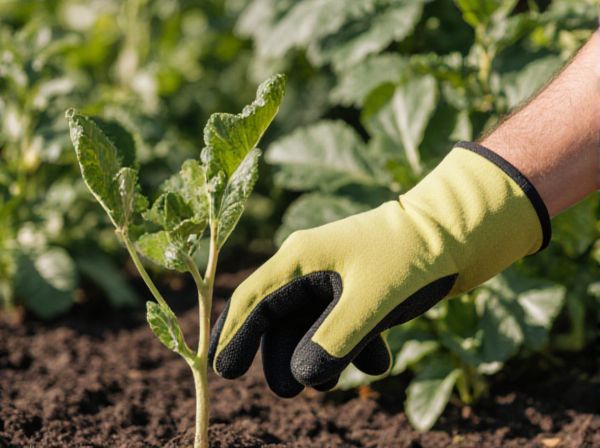
Permaculture vs Traditional vegetable gardening Illustration
Permaculture emphasizes sustainable, self-sufficient ecosystems by mimicking natural patterns, promoting biodiversity, and reducing waste, whereas traditional vegetable gardening often relies on monoculture and regular soil disturbance. Permaculture designs integrate perennial plants, companion planting, and organic soil management to create resilient food systems with minimal external inputs. Traditional gardening typically requires more frequent maintenance, including tilling, fertilizing, and pest control, which can impact long-term soil health and ecosystem balance.
Table of Comparison
| Aspect | Permaculture Gardening | Traditional Vegetable Gardening |
|---|---|---|
| Design Approach | Holistic, mimics natural ecosystems | Linear, plot-based layout |
| Soil Health | Focus on building rich, living soil with compost and mulch | Often relies on tilling and synthetic fertilizers |
| Biodiversity | High biodiversity with mixed crops and companion planting | Monoculture or limited crop diversity |
| Water Management | Efficient use through rainwater harvesting and swales | Typically uses irrigation systems without water conservation methods |
| Pest Control | Natural pest management using beneficial insects and plants | Often depends on chemical pesticides |
| Labor Intensity | Initial setup intensive but low maintenance over time | Continuous labor required for soil prep and pest control |
| Yield | Steady, sustainable yields over long term | High yields in short term but can degrade soil health |
| Environmental Impact | Low impact, promotes ecosystem health | Higher impact due to chemical inputs and soil erosion |
Understanding Permaculture in Edible Gardening
Permaculture in edible gardening emphasizes creating self-sustaining ecosystems by integrating plants, animals, and natural resources to enhance soil health and biodiversity. This approach focuses on perennial crops, companion planting, and natural water management techniques to reduce external inputs and improve resilience. Traditional vegetable gardening often relies on seasonal planting and regular soil disturbance, whereas permaculture prioritizes long-term ecological balance and productivity.
Key Principles of Traditional Vegetable Gardening
Traditional vegetable gardening emphasizes crop rotation, soil tillage, and the use of synthetic fertilizers to maximize yield and control pests. It often relies on monoculture planting patterns and regular irrigation to promote growth in defined plots. Soil preparation and nutrient management remain central to optimizing plant health and productivity in this method.
Design Approaches: Permaculture vs Traditional Gardens
Permaculture design emphasizes ecological principles, integrating diverse plant species and natural patterns to create self-sustaining, resilient garden ecosystems that conserve water and improve soil health. Traditional vegetable gardening typically involves monoculture crops arranged in linear rows, requiring regular external inputs such as fertilizers and pesticides for optimal yield. Permaculture's holistic approach reduces maintenance and enhances biodiversity, whereas traditional methods prioritize simplified management and immediate crop production.
Soil Health and Fertility Management
Permaculture emphasizes building soil health through perennial plant systems and diverse crop rotations, enhancing organic matter and microbial activity for long-term fertility. Traditional vegetable gardening often relies on annual tilling and synthetic fertilizers, which can degrade soil structure and reduce biodiversity. Incorporating permaculture principles promotes sustainable nutrient cycling and resilience, leading to improved soil fertility and productivity over time.
Water Conservation Techniques Compared
Permaculture employs key water conservation techniques such as rainwater harvesting, swales, and mulching to maximize moisture retention and reduce irrigation needs in vegetable gardening. Traditional gardening often relies on regular watering schedules and drainage systems, which can lead to increased water usage and soil erosion. By integrating permaculture principles, gardens enhance soil structure and promote natural water cycles, resulting in sustainable water management and improved crop resilience.
Plant Selection and Diversity Strategies
Permaculture emphasizes selecting native and perennial plants that support ecosystem health and biodiversity, often integrating companion planting to enhance soil fertility and pest control. Traditional vegetable gardening typically concentrates on annual crops with a focus on maximizing yield through monoculture or crop rotation practices. Diverse plant selection in permaculture creates resilient systems with natural pest resistance, whereas traditional methods rely more on external inputs for maintaining soil and plant health.
Pest and Disease Control Methods
Permaculture employs integrated pest management techniques such as companion planting, biodiversity enhancement, and natural predator encouragement to maintain pest and disease balance, reducing chemical inputs. Traditional vegetable gardening typically relies on synthetic pesticides and fungicides to control infestations and diseases, which can lead to resistance and environmental harm. Emphasizing soil health and ecosystem resilience, permaculture fosters long-term pest suppression and plant vigor compared to conventional approaches.
Yield and Productivity Analysis
Permaculture integrates diverse plant species and sustainable practices that enhance soil health, resulting in higher long-term yields and greater resilience compared to traditional vegetable gardening. Traditional methods often rely on monoculture and frequent tilling, which can deplete soil nutrients and reduce productivity over time. Studies show permaculture systems increase overall productivity by promoting natural nutrient cycles and minimizing external inputs, leading to more efficient food production per unit area.
Sustainability and Environmental Impact
Permaculture emphasizes sustainable practices by mimicking natural ecosystems, promoting soil health, water conservation, and biodiversity, which reduces the need for synthetic fertilizers and pesticides common in traditional vegetable gardening. Traditional methods often rely on monoculture and intensive tilling, leading to soil degradation, reduced biodiversity, and increased greenhouse gas emissions. Adopting permaculture principles enhances long-term environmental resilience and supports sustainable food production by maintaining ecological balance.
Choosing the Right Approach for Your Garden
Permaculture emphasizes sustainable, eco-friendly practices by mimicking natural ecosystems, integrating diverse plants, and conserving resources to create a self-sustaining garden. Traditional vegetable gardening often focuses on row crops, seasonal planting, and intensive management for maximum yield within a shorter timeframe. Assessing your local climate, soil conditions, available space, and long-term goals helps determine whether the regenerative benefits of permaculture or the structured productivity of traditional gardening better suits your edible garden's needs.
Permaculture vs Traditional vegetable gardening Infographic

 gardendif.com
gardendif.com